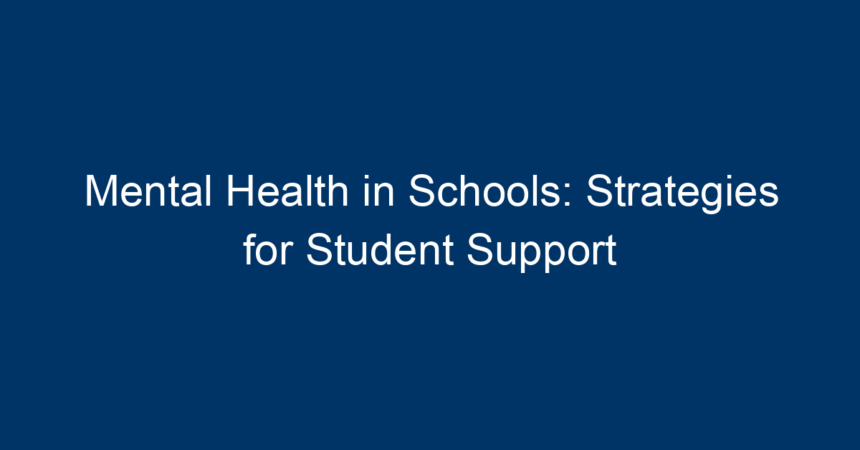Introduction
In today’s fast-paced and often stressful world, mental health in schools has become a pressing concern for educators, parents, and communities alike. The rise of anxiety, depression, and other mental health issues among students calls for immediate attention and effective intervention strategies. Schools are not just places of academic learning; they play a crucial role in nurturing the overall well-being of students. This article explores vital strategies to support student mental health, offering actionable insights for teachers, administrators, and parents.
Understanding Mental Health in Schools
The Importance of Mental Health
Mental health encompasses emotional, psychological, and social well-being. It affects how students think, feel, and act. High levels of stress, bullying, and academic pressure can significantly impact students’ mental health. Therefore, addressing mental health in schools is not only beneficial but essential for fostering an environment conducive to learning.
The Scope of the Issue
Statistics showcase the increasing prevalence of mental health issues among children and adolescents. According to the National Institute of Mental Health, one in five children experiences a mental health disorder at some point. This statistic underlines the urgency behind integrating mental health support in school environments.
Strategies for Supporting Mental Health in Schools
1. Creating a Supportive Environment
Encouraging Open Communication
Establishing an atmosphere where students feel safe to express their feelings is crucial. Schools can implement regular check-ins and open forums where students can voice their concerns without fear of judgment.
Building Strong Relationships
Teachers and staff should foster strong relationships with students. Personal connections can make students feel valued and understood, ultimately promoting better mental health.
2. Training Staff and Educators
Professional Development
Investing in mental health training for teachers and school staff is vital. Educators equipped with knowledge about mental health can identify early signs of distress and intervene appropriately.
Implementing a Mental Health Curriculum
Incorporating mental health education into the existing curriculum helps students understand their emotions better. Lessons on coping strategies and emotional intelligence can empower students to navigate their mental health needs effectively.
3. Providing Accessible Resources
Counseling Services
Access to on-site counseling services ensures that students can get help when needed. Schools should promote these services actively and make it easy for students to seek help without stigma.
Mental Health Awareness Campaigns
Regular mental health awareness campaigns in schools can destigmatize mental health issues. Events like Mental Health Awareness Month can serve as platforms for education and engagement.
4. Encouraging Physical Health
Promoting Healthy Lifestyles
Physical health and mental health are inherently connected. Schools should encourage physical activity through sports and exercise programs, promoting a holistic approach to wellness.
Nutritious Meal Programs
A balanced diet impacts cognitive functions and emotional well-being. Schools should provide nutritious meal options that foster better mental health among students.
5. Engaging Families and Communities
Parent Workshops
Schools can offer workshops for parents on how to recognize mental health issues and how to support their children effectively. Engaging families creates a supportive network for students outside school.
Collaborating with Community Resources
Forming partnerships with local mental health organizations can expand the support network available to students. These collaborations can provide additional resources and expertise that schools may lack.
6. Implementing Mindfulness and Relaxation Techniques
Mindfulness Programs
Studies have shown that mindfulness practices can reduce anxiety and improve emotional regulation. Schools can implement programs that teach students mindfulness techniques, such as meditation or breathing exercises.
Creating Calm Spaces
Designating quiet areas within the school where students can take breaks can significantly reduce stress. These spaces should be peaceful and equipped with resources for relaxation, such as books or calming activities.
The Role of Technology in Supporting Mental Health
Digital Resources
Technology can be a powerful ally in supporting mental health in schools. Digital platforms can provide access to mental health resources, online counseling, and apps designed to help manage stress and anxiety.
Teletherapy Options
For students who may not feel comfortable seeking help in person, teletherapy offers an alternative. Schools should consider integrating teletherapy options to expand access to mental health care.
Conclusion: Actionable Insights for Schools
Addressing mental health in schools requires a multifaceted approach that involves educators, parents, and the community. Here are some actionable insights for implementing effective strategies:
-
Promote Open Communication: Foster a culture where students feel safe expressing their feelings and seeking help.
-
Invest in Training: Equip teachers and staff with the knowledge to identify and address mental health issues effectively.
-
Enhance Resources: Ensure access to counseling and support through awareness campaigns and partnerships with local mental health organizations.
-
Encourage Physical Health: Support programs that promote physical well-being, including nutrition and exercise.
-
Engage Families: Provide workshops and resources for parents to understand and aid their children’s mental health needs.
- Utilize Technology: Embrace digital tools that can facilitate mental health support, such as teletherapy and mindfulness apps.
By prioritizing mental health in schools, we can create an environment where students not only excel academically but also thrive emotionally and socially. Investing in our students’ mental wellness today will yield long-term benefits for individuals and society as a whole.
In the journey towards better mental health in schools, every small step counts. Let’s commit to creating spaces where our students feel heard, supported, and empowered to reach their full potential.




